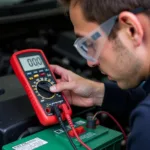The dreaded check engine light. It can strike fear into even the most seasoned driver, leaving you wondering about the severity of the issue and potential costs lurking ahead. Whether a steady glow or a frantic blinking, understanding what your car repair check engine light means is crucial for peace of mind and timely action.
What Does the Check Engine Light Mean?
Your car’s engine is a complex system, monitored by a network of sensors that communicate with the onboard computer. When one or more sensors detect an issue, the computer triggers the check engine light on your dashboard. This light, often appearing as an engine outline or the words “Check Engine,” serves as a general warning signal.
Contrary to popular belief, the check engine light doesn’t necessarily indicate a catastrophic engine failure. The issue could be as simple as a loose gas cap or as complex as a faulty catalytic converter.
Common Causes of a Car Repair Check Engine Light
While a mechanic’s diagnosis is essential for pinpointing the exact cause, here are some of the most common culprits behind a glowing check engine light:
- Emissions System Issues: Problems with the oxygen sensor, catalytic converter, or evaporative emissions system can trigger the light.
- Ignition System Malfunctions: Faulty spark plugs, ignition coils, or wiring can disrupt engine performance and illuminate the check engine light.
- Loose Gas Cap: A seemingly minor issue, a loose or missing gas cap can disrupt fuel system pressure and trigger the warning light.
- Sensor Failures: Various sensors, such as the mass airflow sensor or throttle position sensor, can malfunction and send erroneous signals to the computer.
- Faulty Catalytic Converter: A failing catalytic converter, responsible for reducing harmful emissions, can cause significant performance issues and trigger the check engine light.
What to Do When Your Check Engine Light Turns On
- Don’t Panic: While the check engine light can be unsettling, it doesn’t always warrant immediate panic. Pull over when safe to assess the situation.
- Check Your Gas Cap: Ensure your gas cap is securely tightened. Sometimes, a simple loose cap is the culprit.
- Monitor Your Car’s Performance: Pay attention to any unusual noises, vibrations, loss of power, or changes in fuel economy.
- Get a Diagnostic Check: The most crucial step is to visit a qualified mechanic as soon as possible to get a proper diagnosis using a car diagnostic tool. This tool reads the error codes stored in your car’s computer, pinpointing the problem area.
Car Check Engine Light Repair: Reno, NV
If you’re in the Reno, Nevada area and facing car repair check engine light concerns, don’t hesitate to reach out to a trusted local mechanic. Prompt diagnosis and repair can save you from costly repairs and ensure your vehicle operates safely and efficiently.
car check engine light repair reno nv
My Car Check Engine Light When Off After Repair
It’s generally a good sign if your car check engine light turns off after a repair. This indicates the issue has likely been resolved, and the car’s computer has cleared the error code. However, if the light comes back on shortly after the repair, it’s essential to return to the mechanic to re-evaluate the situation.
my car check engine light when off after repair
Does Check Engine Light Come on After Car Repair?
While uncommon, it’s possible for the check engine light to come on after a seemingly unrelated car repair. This could occur if:
- The mechanic accidentally left a sensor unplugged.
- The repair disturbed a pre-existing issue, causing it to trigger the light.
- A new problem arose coincidentally.
If your check engine light illuminates after a repair, it’s crucial to contact the mechanic who performed the service to address the issue promptly.
does check engine light come on after car repair
How to Repair the Check Engine Light in a Car
Attempting to repair a check engine light issue yourself without proper knowledge and tools can be risky and potentially worsen the problem. Consulting a qualified mechanic is always recommended for accurate diagnosis and repair.
However, here are some general steps involved in addressing check engine light problems:
- Retrieve Error Codes: Mechanics use a diagnostic scanner to retrieve error codes stored in the car’s computer, pinpointing the problem area.
- Diagnose the Issue: Using their expertise and the retrieved codes, mechanics analyze the data and perform visual inspections to determine the root cause of the problem.
- Repair or Replace Components: Depending on the diagnosis, mechanics will repair or replace faulty components, such as sensors, spark plugs, or other engine parts.
- Clear Error Codes: Once repairs are complete, mechanics clear the error codes from the computer, turning off the check engine light.
- Verify the Repair: A final test drive and system check ensure the repair successfully addressed the issue, and the check engine light doesn’t reappear.
how to repair the check engine light in a car
Car Antenna Repair Cause Engine Light to Come On?
While seemingly unrelated, it’s possible for car antenna repair to indirectly cause the check engine light to illuminate in rare instances. If the antenna repair involves accessing areas near engine components or wiring harnesses, there’s a slight chance of disturbing a sensor, connector, or wire, potentially triggering the check engine light. However, it’s more likely that a pre-existing issue coinciding with the antenna repair is the culprit.
car antena repair cause engine light to come on
Conclusion
Addressing a car repair check engine light promptly is crucial for maintaining your vehicle’s health and preventing further damage. While the light can seem daunting, understanding its purpose and seeking professional help can save you from costly repairs and ensure a smooth, safe ride.


